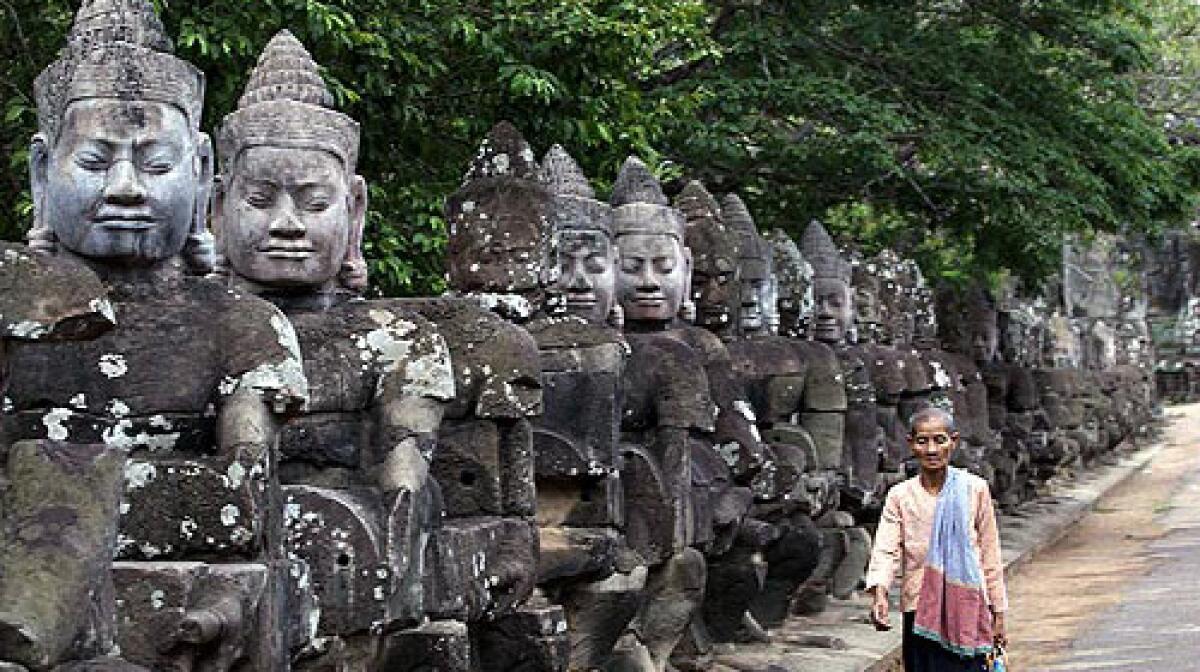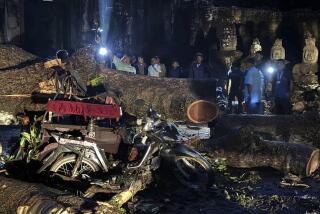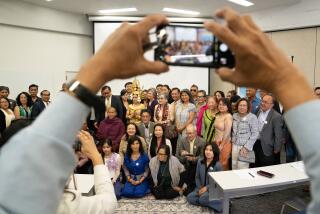Too much adoration at Cambodia’s Angkor temples

Angkor, Cambodia
The ancient sandstone temples of Angkor have stood up to endless assaults down the centuries, from medieval raiders armed with clubs and spears to genocidal looters laying land mines.
These days, the onslaught begins in the early-morning darkness, when invading columns of buses, taxis and sputtering tuk-tuks converge on a dirt parking lot across from Angkor Wat’s broad moat.
They disgorge hundreds of camera-wielding tourists, who march through the gray light toward the awesome gates of the world’s largest religious monument.
Hindus constructed it in the 12th century, with a gilded central tower representing Mt. Meru, mythical home of the gods and the center of the spiritual and physical universes. They built it facing west, perhaps in honor of the Hindu god Vishnu, preserver of all things.
For today’s tourists, the alignment has a more mundane appeal. It’s a great place to snap a picture of the sunrise behind sprawling Angkor’s best-known temple.
When the shutters stop clicking, tour guides herd their groups into the monument all at once. Tourists jostling for space bump, scrape and rub their fingers against exquisitely carved stone, adding to centuries of damage to the friezes of soldiers depicted in epic battle atop chariots and elephants.
By dusk, the mob of sightseers has moved to Phnom Bakheng, where buses drop off hundreds of people who then scramble for position on large, delicately balanced stone platforms at the small temple, Angkor’s oldest.
Obscured from the road by dense forest, it was safely off the regular tour routes until sappers cleared land mines that Khmer Rouge guerrillas had placed to defend the strategic hilltop.
“Now it’s suddenly become the destination where everybody wants to be at the end of the day to see the sunset, and to see the views, which are spectacular,” said Bonnie Burnham, president of the New York-based World Monuments Fund. The nonprofit group helps conserve historic sites around the world.
Many of Phnom Bakheng’s 108 shrines stand on platforms that have shifted over the centuries as water trickles in and loosens sand and dirt, and the tourists are gathering where they shouldn’t. So many people have clambered up stones next to the crowded stairs that erosion is accelerating, with loosened sections poised to tumble, Burnham said.
“The platforms where people stand are not really stable,” Burnham said. “They’re eroding very rapidly. The magnificent sculpture on the shrine at the center of the temple is in very fragile condition and has not been treated for conservation yet.
“People shouldn’t really be touching it, or going anywhere near it,” she said.
Burnham’s fund received almost $1 million last month from the State Department for a project to stabilize the eastern side of Phnom Bakheng, the temple’s most endangered section.
As night falls, the tourists feel their way back down the hill and onto air-conditioned buses. They’re delivered to their hotels in nearby Siem Reap, where they rinse off the sweat of a long day’s touring with a dip in the pool or a soothing shower before dinner.
As the taps open up, more of the dwindling ground water is drained. UNESCO has warned that the receding water table could undermine Angkor Wat’s fragile foundations, causing the temple to gradually sink.
There hasn’t been enough research to say how much the heavy demand for water affects Angkor Wat’s stability, said Dougald O’Reilly, a Canadian archaeologist who heads , a nonprofit group working to protect Cambodia’s historic sites from looters and overuse.
A decade ago, about 300,000 tourists visited Angkor Wat each year. It was possible to have a quiet, spiritual moment alone in nearby temples that had been swallowed up by the jungle.
But peace, after decades of civil war and upheaval, opened the tourism floodgates. More than a million people are expected to file through Angkor Wat’s narrow stone corridors this year, and the government hopes to draw 3 million to the site by 2010.
With more hotels and resorts on the drawing board, conservationists are pushing hard to prevent a destructive free-for-all of development and tourism.
“It’s going to mean some sacrifices,” Burnham said. “People aren’t going to be able to do some of the things, in an unregulated way, that they’ve been permitted to do in the past.”
Angkor’s temples aren’t new to the indignities of visitors with sharp elbows.
Numerous armies have barged through the city-state founded 1,200 years ago. Its temples were abandoned to the jungle during almost half that period. Angkor Wat suffered its worst damage when Khmer Rouge fighters looted it in the late 1970s as they were committing mass murder in the name of an agrarian revolution.
Foreign donors and governments, led by the U.S., France and Japan, have spent as much as $50 million over the last 15 years to repair the scars of time and abuse. But the work is far from finished, and new threats are building.
Sokimex Group, which has used its connections with Cambodian Prime Minister Hun Sen to become the country’s biggest company, plans to build a 900-room hotel and spa, with shopping mall, water park, slot machines and conference center, on a 56-acre site in Siem Reap.
Sokimex also controls the ticket concession to Angkor. Passes cost $20 a day, $40 for three days and $60 a week. It’s small change for a company that deals in oil, gas stations, pharmaceutical products, garment making, property development and luxury hotels and resorts, in addition to running an airline.
Sokimex’s share of the admission take is set by a contract with the government, and Burnham said it leaves most of the profit in the company’s hands. One-third of the revenue is supposed to go to Apsara, a Cambodian agency set up by royal decree to preserve the Angkor sites and manage development.
But some people dispute the ticket sales figures, saying Apsara -- which takes its name from the heavenly nymphs of Hindu and Buddhist mythology whose bare-breasted figures adorn the Angkor temple walls -- gets enough only to cover basic expenses.
“Apsara has virtually no money for conservation,” Burnham said. “All of the conservation at Angkor is being done through international assistance.”
The effect of millions of feet pounding on Angkor Wat’s steps and floors already has led officials to close some areas. The towers, the tallest of which rises 213 feet, are off limits because the constant wear and tear made the structures unsafe.
A first step toward reducing congestion could be as simple as insisting that visitors walk through Angkor Wat in the same direction, from beginning to end, Burnham said.
She also wants to see Cambodian officials set time constraints on tickets for the busiest of Angkor’s temples, to limit pressure during peak hours.
The day may come when a strict quota is placed on the number of visitors allowed at certain monuments, Burnham said. But O’Reilly hopes to avoid that by persuading tourists and their guides to make better choices.
O’Reilly is deputy director of the Greater Angkor Project, a team of researchers at Australia’s University of Sydney who in recent years have discovered how vast ancient Angkor was by studying images taken by NASA satellites and an ultralight plane.
Their theory is that the city’s 15th century collapse occurred largely because people neglected their environment, cutting down too many trees to expand rice paddies, causing waterways to fill with silt.
If they’re right, it’s a cautionary tale for the 21st century, as overdevelopment threatens the magnificent buildings and art that ancient Angkor left behind.
More to Read
Sign up for The Wild
We’ll help you find the best places to hike, bike and run, as well as the perfect silent spots for meditation and yoga.
You may occasionally receive promotional content from the Los Angeles Times.






